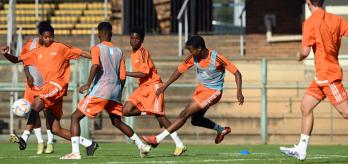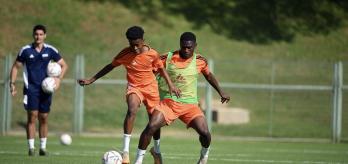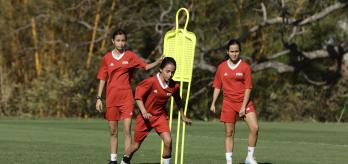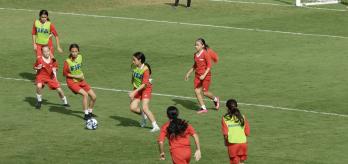Methodology
What is practised?
This passing circuit is designed to enhance a defender’s anticipation skills when approaching a receiving player from behind. Defenders must pay attention to the timing of their approach to ensure that they do not arrive too late and are easily bypassed, or arrive too early and possibly end up committing a foul. By focusing on precise acceleration and deceleration, with effective contact, the defender can dispossess the receiver without committing a foul. The defender must consider from which side they approach the receiver so as to avoid misjudging the situation, which would see them afford their opponent space and be easily turned, putting their team on the back foot.
For whom is this relevant?
This circuit revolves around the player, focusing on their defensive anticipation when pressing to regain possession. The defender’s role in the circuit simulates their involvement in any phase of the opposition’s build-up and ball progression in which they have triangular passing options. The exercise is specifically aimed at helping the defender to force the receiving player backwards or sideways, thereby preventing them from turning and facing forward to spring an attack. This defensive approach can be applied in both high-pressing systems and when a team set up in a mid-block. The circuit is non-position-specific and focuses solely on a player’s actions when out of possession.
How is the practice designed?
This exercise involves an opposed passing circuit that is designed to sharpen a defender’s actions and heighten their awareness when approaching an opposing player from behind. The position of the central cones in relation to the mannequins ensures that the passes played into the centre of the exercise area are diagonal passes, which simulate those typically played in the build-up and ball progression phases. The defender’s starting position and the distance to the receiver mean that they must accelerate quickly to press their opponent. The direction of play involved in the circuit gives the defender an indication of the area where they must press, thereby reducing the level of difficulty. The pressure applied by the defender forces the receiving player to pay attention to their control.
Session plan
Organisation
-
Mark out a 20m x 20m exercise area delimited by a mannequin in each corner.
-
Locate the midpoint of the exercise area and place 2 cones 5m apart (widthways).
-
Place 2 players behind each other at each mannequin and a player at each of the cones in the middle of the exercise area.
-
Give the first player at one of the mannequins a ball (C).
-
The player at the cone closest to the ball carrier is the receiver (A) and the player at the other cone is the defender (B).
Explanation
-
The exercise begins with C in possession, who then plays a firm pass to A's stronger foot.
-
As soon as C plays the pass to A, B darts out from their cone to apply pressure on A from behind.
-
A controls the ball before playing a pass to the first player at the next mannequin in a clockwise direction.
-
The player stationed at that next mannequin takes a touch to control the ball before playing a pass to the first player at the next mannequin in a clockwise direction.
-
The sequence is repeated, starting from the diagonally opposite corner of the exercise area to where it began.
-
In-possession players rotate positions by following their passes. After having applied pressure on A, B returns to their starting cone in readiness to receive a pass from the player at the next mannequin in a clockwise direction.
Key coaching points
Roles of the coaches
-
First coach: leads the session and coaches the defender.
-
Second coach: coaches the players stationed at the mannequins on their passing and the receiving player on their ball reception.























